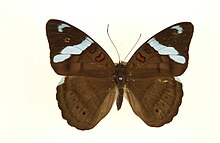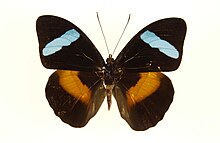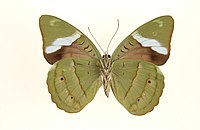| Nessaea obrinus | |
|---|---|

| |
| Female | |

| |
| Male | |
| Scientific classification | |
| Domain: | Eukaryota |
| Kingdom: | Animalia |
| Phylum: | Arthropoda |
| Class: | Insecta |
| Order: | Lepidoptera |
| Family: | Nymphalidae |
| Genus: | Nessaea |
| Species: | N. obrinus |
| Binomial name | |
| Nessaea obrinus (Linnaeus, 1758) | |
| Synonyms | |
| |

Nessaea obrinus, the obrina olivewing, is a species of butterfly of the family Nymphalidae. It is found from Colombia and the Guianas to the mouth of the Amazon and south to central Bolivia and Mato Grosso in Brazil, extending to northern Argentina.

The length of the wings is 25–40 mm for males and 26–41 mm for females. Adults of subspecies obrinus are on wing in January and from July to November. Adults of subspecies faventia are on wing year round, but mainly from June to October and adults of subspecies lesoudieri are on wing year round, with no observed peak of abundance.
Blue pigmentation
Obrina Olivewing butterflies are very unusual because they are one of the few animals with actual blue pigment. Most other species get their blue coloration from a process called coherent scattering, in which scattered light waves interfere to create a blue color. All the other species of Nessaea get their blue coloration from the pigment pterobilin. Pterobilin also provides blue for Graphium agamemnon, G. antiphates, G. doson, and G. sarpedon. Other butterflies in Graphium and Papilio (specifically P. phorcas and P. weiskei) use the blue pigments phorcabilin and sarpedobilin.
Subspecies
- Nessaea obrinus obrinus (Guianas and in eastern Venezuela)
- Nessaea obrinus faventia Fruhstorfer, 1910 (Brazil (Mato Grosso), Bolivia)
- Nessaea obrinus lesoudieri Le Moult, 1933 (Colombia, Ecuador, Peru, Bolivia, Brazil (Amazonas))
References
- "Nessaea Hübner, [1819]" at Markku Savela's Lepidoptera and Some Other Life Forms
- "Neotropical Nymphalidae VII. Revision of Nessaea" (PDF). ufl.edu.
- Joe, Hanson (9 January 2018). "Why Is Blue So Rare In Nature?". It's Okay To Be Smart. 8:26 minutes in. PBS. Retrieved 7 February 2018.
- Vane-Wright, Richard I. (22 February 1979). "The coloration, identification and phylogeny of Nessaea butterflies (Lepidoptera : Nymphalidae)" (PDF). Bulletin of the British Museum (Natural History). Entomology Series. 38 (2): 27–56. Retrieved 8 February 2018.
- ^ Simonis, Priscilla; Serge, Berthier (30 March 2012). "Chapter number 1 How Nature produces blue color". In Massaro, Alessandro (ed.). Photonic Crystals - Introduction, Applications and Theory. InTech. doi:10.5772/32410. ISBN 978-953-51-0431-5. Retrieved 8 February 2018.
| Taxon identifiers | |
|---|---|
| Nessaea obrinus | |
This article related to members of the butterfly subfamily Biblidinae is a stub. You can help Misplaced Pages by expanding it. |